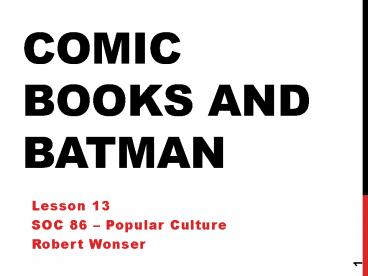Comic Books and Batman PowerPoint PPT Presentation
1 / 16
Title: Comic Books and Batman
1
Comic Books and Batman
- Lesson 13
- SOC 86 Popular Culture
- Robert Wonser
2
Comics
- Stand out as an overarching symbol of pop culture
itself. - They are ephemeral, timely and werent designed
to last.
3
Peanuts
- The characters are all children but they seem to
have much more insight into life than do adults,
who are relegated to the margins of the strip. - Its tone is subtle sadness, a veiled angst that
begs the readers to ask the great question of
philosophy Why are we here and What is life all
about?
4
Comic Books
- Comic books epitomize the accessibility, and
appeal to instant gratification that lie at the
core of modern consumer culture.
5
- The preeminent motive shaping comic books has
been the commercial motive of publishers to craft
a product that appeals to paying audiences. - Because the profit is low, publishers have
traditionally emphasized quantity over quality. - This has fueled the use of formulas that can
easily be duplicated as well as adequately speak
to the concerns and expectations of their
audience. - Formulas are ways in which specific cultural
themes and stereotypes become embodied in more
universal story archetypes.
6
- Audiences turn to formulaic stories for the
escape and enjoyment that comes from experiencing
the fulfillment of their expectations within a
structured imaginary world. - Like rock-and-roll, comic books responded to the
emergence of adolescents as a discrete market
with tastes and preoccupations of its own,
sometimes in direct conflict with the mores of
mainstream adult culture.
7
Comic books
8
Graphic Novels
- Starting in the 1970s indie publishers began
competing with the larger publishers. - They experimented with new styles, more
sophisticated formats, and stories suited to
adults. - Graphic Novels are book-length comic books that
tell a single story for adults. - Comics online have become almost completely
ironic in focus (thanks The Simpsons!) - More importantly, irony is a basic mindset
- of the carnivalesque.
9
Reading Comic Books
- The Superhero genre is still popular today
because as Barthes argued it recycles an ancient
codethe code of the hero. This code includes - A life-saving journey in infancy Superman had to
leave his home planet of Kypton to avoid being
destroyed along with it. - An obscure childhood little is known about the
early lives of most superhero characters. - Orphanage some superheroes, like Batman,
Captain Marvel, Black Panther and Cyclops, have
lost their parents as had many ancient mythic
heroes.
10
Barthes code of the hero
- Superhuman powers possessed by all superheroes
(physical or intellectual). Sometimes gained in
unusual ways (e.g. Spider-man being bitten by an
irradiated spider gone berserk). He gains his
spider sense, spiders web. - A fatal weakness exposure to kryptonite,
blindness (Daredevil), psychological problems
(the Hulk), the fatal weakness is a basic feature
of the hero codeAchilles had a weak heal,
Samsons strength depended on his hair, etc.
11
- Selfless dedication to the common good usually
at their own expense, the heroes of ancient myths
and the comic book superheroes exist to help the
common folk. - A magic weapon Norse god Thor had a powerful
hammer. Spider-man has his web shooter, Iron Man
has a sophisticated suit of armor Batman his
sophisticated car and array of gadgets, etc.
12
Reading Batman Comics
- In 1954 Frederic Wertham published Seduction of
the Innocent - Mostly about horror comics but contained four
pages that suggested there were homoerotic
overtones in Batman comics - "At home they lead an idyllic life. They are
Bruce Wayne and "Dick" Grayson. Bruce Wayne is
described as a "socialite" and the official
relationship is that Dick is Bruce's ward. They
live in sumptuous quarters, with beautiful
flowers in large vases, and have a butler,
Alfred. Bruce is sometimes shown in a dressing
gown. As they sit by the fireplace the young boy
sometimes worries about his partner it is like a
wish dream of two homosexuals living together."
Dr Fredric Wertham, Seduction of the Innocent
(1954)
13
Is Batman Gay?
- Interesting the moral panic that ensued
- Comics were thought to promote deviancy
14
Moral Panic and Comic Books
- Superheroes have evoked moral panic
- In the 1950s concern over violence led to senate
hearings. - However as moral panic theory suggests, the
public outrage and concern was to last only a
brief period. - By the 1970s comic books were seen as not only a
simple form of entertainment, but also as
mementos of a previous, supposedly more innocent
period (one in which propaganda could be
blatant!).
15
Comic Books and Propaganda
16
(No Transcript)

